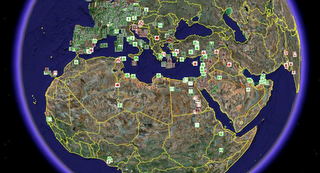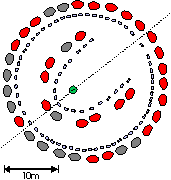The Megalithic Portal has a file that can be opened in Google Earth to illustrate the location of all megalithic monuments.
 The most famous neolithic monument, Stonehenge in Wiltshire, England, was constructed from 2750 BC to 1500 BC. Built in several phases, it is a series of concentric rings, utilizing post and lintel. In addition, it consists of a number of uprights, sacred "blue" stones, and a circle of movable "marker stones" set in pits. There is a landscaped trench on the exterior of the rings. Similar to other megalithic structures, the work was executed through highly accurate engineering and by utilizing techniques for mass transportation from far distances.
The most famous neolithic monument, Stonehenge in Wiltshire, England, was constructed from 2750 BC to 1500 BC. Built in several phases, it is a series of concentric rings, utilizing post and lintel. In addition, it consists of a number of uprights, sacred "blue" stones, and a circle of movable "marker stones" set in pits. There is a landscaped trench on the exterior of the rings. Similar to other megalithic structures, the work was executed through highly accurate engineering and by utilizing techniques for mass transportation from far distances. 
Weighing in at 45 tons each, the standing stones are the weight of a semi-trailer truck. They are around 22 feet in height or about the height of two field goal posts stacked atop one another. Looking at the plan below, the layout has a centralized plan with the uprights set on an axis. The form successfully provides an enclosure yet with open space, enabling one to experience the landscape from the interior.
 There are over 40,000 megalithic structures around Europe. Theories have been developed that link the placement of megalithic forms with the fear of floods from the gods. It has been used to explain their sudden birth, widespread development, and their relationship to the sea. Such a theory is further discussed on this site.
There are over 40,000 megalithic structures around Europe. Theories have been developed that link the placement of megalithic forms with the fear of floods from the gods. It has been used to explain their sudden birth, widespread development, and their relationship to the sea. Such a theory is further discussed on this site.The knowledge as a whole about the history, development, and forms used in megalithic structures is directly relevant to megastructures today. How might a megalithic structure look in today's world? What characteristics would both the form of the Neolithic Age and the form of today share?

No comments:
Post a Comment